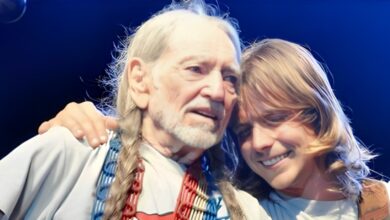Hank Williams’ Unforgettable Grand Ole Opry Debut with “Lovesick Blues”
Hank Williams’ first appearance at the Grand Ole Opry on June 11, 1949, is a landmark event in the history of country music. At just 25 years old, Williams had already gained recognition with hits like “Move It On Over” and “Honky Tonkin’.” However, it was his performance of “Lovesick Blues” that propelled him to national stardom, topping the country charts and drawing the attention of the Opry’s management.
That evening, the Ryman Auditorium, famously known as the “Mother Church of Country Music,” was filled to capacity. Among the audience were 230 young women from Volunteer Girls State, a citizenship training program. Their attendance brought a unique vibrancy to the crowd, as many were experiencing Nashville for the first time. This youthful energy contrasted with the typically older Opry audience, creating the perfect setting for an unforgettable night.
Uncertain about how Williams would be received, Opry management scheduled him for a later segment alongside Ernest Tubb, avoiding the nationally broadcast hour on NBC Radio. When Williams took the stage, the auditorium erupted in applause, especially from the Volunteer Girls State attendees. He began performing “Lovesick Blues,” captivating the audience and earning multiple encores—a rare achievement at the Opry. The enthusiasm of the young women energized the entire crowd, establishing Williams as a true icon in country music.
This performance was not only a significant milestone in Williams’ career but also highlighted the changing demographics of country music audiences. The positive response from the younger attendees showcased the genre’s expanding appeal and the influence of diverse audiences on live performances.
Born Hiram King Williams on September 17, 1923, in Mount Olive, Alabama, Hank Williams was raised in a rural environment that deeply influenced his music. He learned to play the guitar from African American blues musician Rufus “Tee-Tot” Payne, who had a profound impact on his musical style. Williams began performing professionally in his teenage years, forming the Drifting Cowboys band and gaining regional popularity.
Despite his rising fame, Williams struggled with personal issues, including alcoholism and health problems. These challenges led to turbulent relationships and affected his professional life. Nevertheless, his exceptional songwriting talent remained undiminished, producing classics like “Your Cheatin’ Heart,” “Hey, Good Lookin’,” and “I’m So Lonesome I Could Cry.”
Williams’ time with the Grand Ole Opry was relatively short. After his successful debut, he became a regular performer but was dismissed in 1952 due to unreliability caused by his personal struggles. Tragically, on January 1, 1953, Williams passed away from heart failure at the age of 29. Despite his brief career, his influence on country music is profound and lasting.
Hank Williams’ legacy continues to inspire generations. His son, Hank Williams Jr., and grandson, Hank Williams III, have both built successful music careers, each forging their own path while honoring the family’s musical heritage. Williams’ songs have been covered by countless artists across various genres, demonstrating the timeless appeal of his work.
In recognition of his contributions, Williams was posthumously inducted into the Country Music Hall of Fame in 1961, the Songwriters Hall of Fame in 1970, and the Rock and Roll Hall of Fame in 1987. His life and music have been the subject of numerous biographies, documentaries, and films, reflecting the enduring fascination with his story.
Hank Williams’ debut at the Grand Ole Opry remains a testament to his talent and the transformative power of music. It serves as a reminder of how a single performance can leave a lasting impact on both an artist’s career and the cultural landscape.





